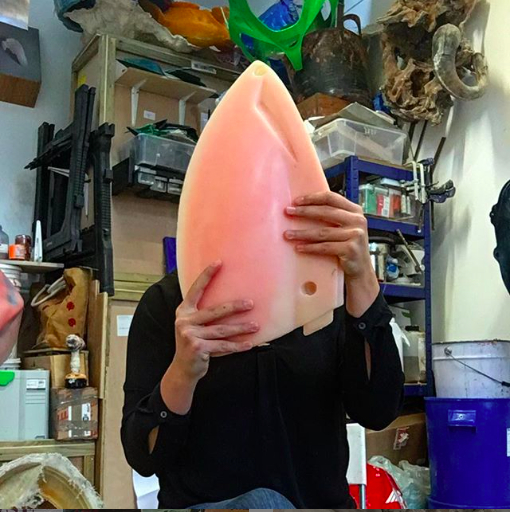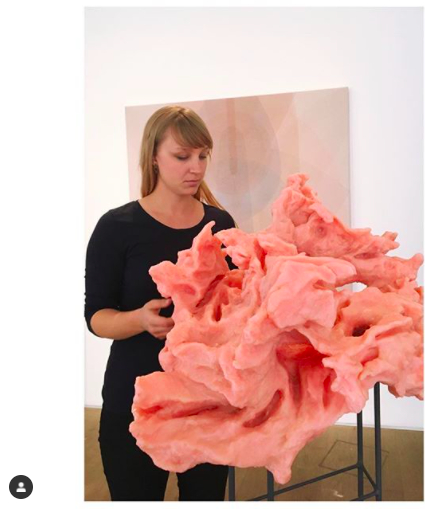My interdisciplinary practice is broad and spans image making, installation and dance making, so my plan had to be equally diverse involving mentoring with an interdisciplinary artist who is a bit further on; and skills based development in Tanztheatre and fabricating objects on environmental scales
Part1: 3am jazz, Tanztheatre and a week in the studio
This blog is about the Tanztheatre element, documenting a week-long intensive led by specialist Adrian Look in May 2018.
My obsessions are psychology and the body, especially the body in movement in relation to other bodies/psychologies. I have read a mountain of popular psychology books and my work is increasingly exploring psychological states.
In June 2016 I made a collaborative work with three dancers for an exhibition at SPACE, London about the failed momentum of the mourning process. Working with Francesco Milgliaccio, Robyn Holder and Marta Polak I took the role of director/choreograpaher, and conceived the concept and text that my collaborators worked from.
I felt it was a breakthrough and I wanted to make more performance work, but as I am currently un-funded paying dancers was tricky and I was finding it hard to get a new project off the ground. I trained 10 years ago, and dance regularly but as I didn’t go down the jobbing dancer route I found myself with two major obstacles:
- That I lacked confidence to get in the studio and make using my own body, I didn’t feel ‘allowed’ to be there really although I spend most of my free time hanging out with professional dancers and know more dance makers than visual artists (!)
- I lacked the experience of dancing other choreographer’s work, and so all I had in my body to use was my classical movement language, and that wasn’t that useful for improvising around the pedestrian, naturalistic movement that interested me. I didn’t know how to translate emotion and intention into my movements and was mechanical or OTT pantomime… it wasn’t working.
The winter before this I started to find my groove by accident. I was heart broken by an exceptional set of circumstances and threw myself into partner dancing. For over a year I spent Friday nights dancing to wailing, melancholy jazz well into the early hours of the morning accompanied by some of the best musicians and dancers on the scene, in the safety of a tiny, crowded, dark corner in Dalston as they jammed around the piano at Tiger Rag.
What I unexpectedly found was the connection with the story of the music, and with another person to counterpoint with I could improvise and express in a way that never came in the studio. I found I responded best to the music that I could find a narrative in.
So I started to take class once a week with Tanztheatre specialist Adrian Look and some longer improvisation sessions, being fascinated by Pina Bausch’s work. What I found was the the Tanztheatre technique wasn’t quite in my body enough to come through in improvisation and I was struggling to tie up the two.
So I took the week-long intensive to close the gap here and to shift my dance practice from a focus on internal mechanisms and technique, to images and communicative qualities of observed movement.
My a-n Artist Bursary supported me to attend his week-long intensive with a group of dancers and actors in Hackney in May, and I have been attending monthly group improvisation sessions with some of the same performers since then.
Six months on I have cleared a space in the studio to improvise regularly and have started to post some of these on Instagram.
Here is what the work of dancing looks like…. my goal was to stay mentally and emotionally present in the movement, from 10 am – 5pm every day for a week. By the evening is was useless! That kind of focus was totally new!
That’s me in the pink top…
Each day we had morning class, repertoire and then improvisation and choreography. Here I am getting some feedback from one of my peers, and struggling to remember the directions. I’m dyslexic which presents huge barriers mirroring and picking up material quickly and was a reason I didn’t have the confidence to audition for performance work…. me smiling during this is a new thing!
Improvisation around random phrases out of a hat ‘He Loves Me, He Loves Me Not’, indecision…
Rules- no dancing.
These were my take-aways at the end of the week that I have been working on over the last six months….
- Dance full out every time. I coast a lot, going through the motions is not possible with this technique, you have to be present throughout your whole body.
- Connection– dancing less but dancing better as a result.
- Soften my technique, hiding it in a way so the audience see’s the content not the container, the feeling not the dancer. All my feedback across jazz partner dancing a contemporary classes has followed the same lines.
- Find a new variation each time you get a chance to repeat a phrase– develop you inventiveness and ability to switch feelings on demand.
- Just get up, get the music on and move, do anything, no judgement
- Posture and managing hypermobility-I habitually let the back of my neck go- my head isn’t always under control. Stabilise the pelvis with cross training- I also have sacroiliac dysfunction which for this week of the intensive was causing me pain and it still is as I write this six months later- physio, no excuses. Wrists- activate them.
- What is your head doing? – this is a choice, mine is often strangely still….
- Keep laughing when it goes wrong, do something and always finish the phrase- you are on stage until you are off.
- Timing- when I’m wrong I usually manage to not loose the music even if Iv’e lost the steps- This is a strength.
- Contrast- flow is good but contrast is just as good, resist the temptation to make everything to even and controlled.
And I made some new friends….
Follow me on Instagram for new work and ideas @alexiszeldastevens


























